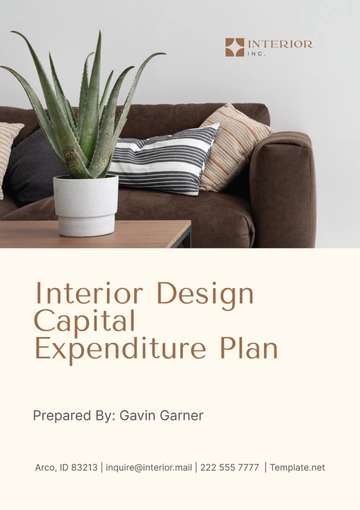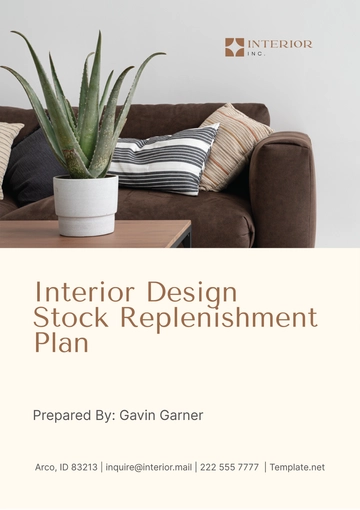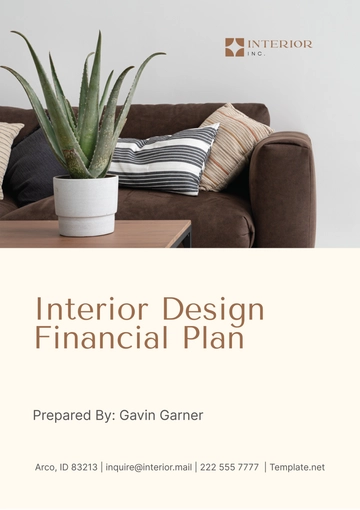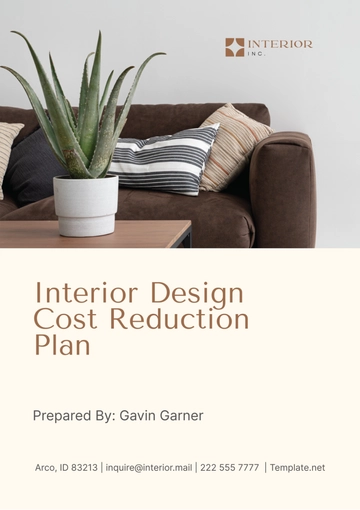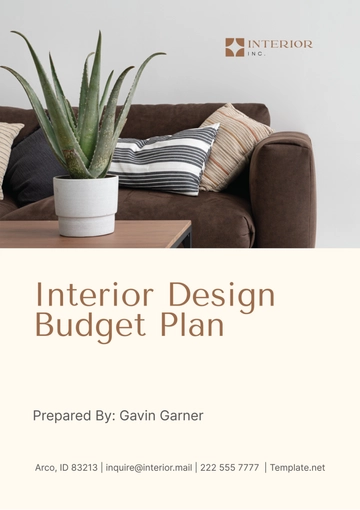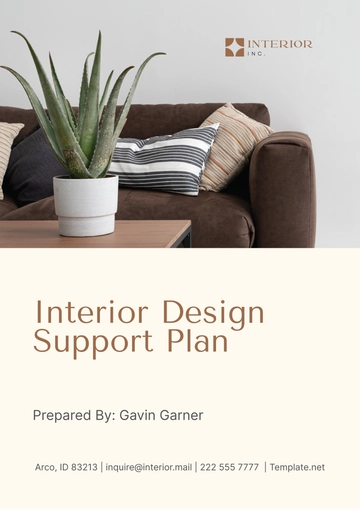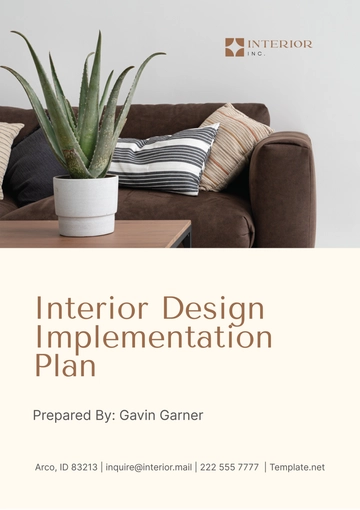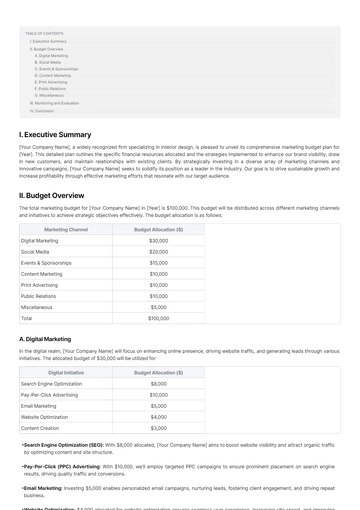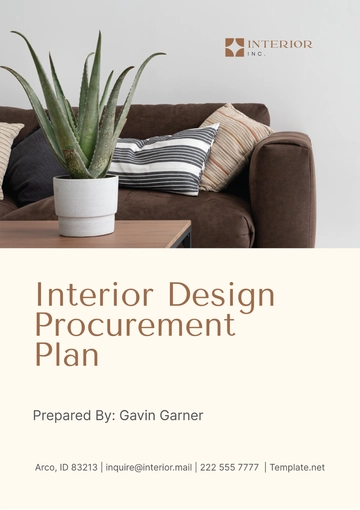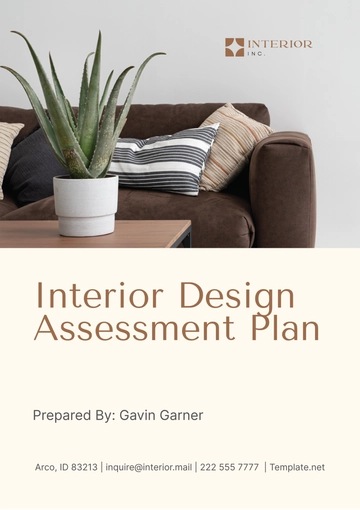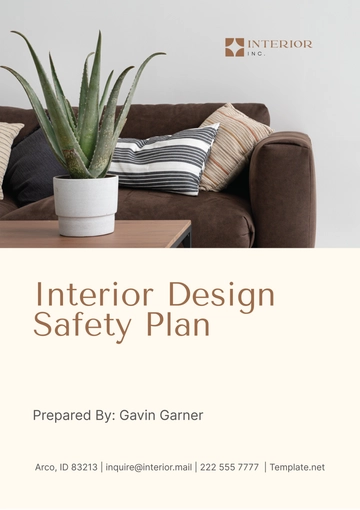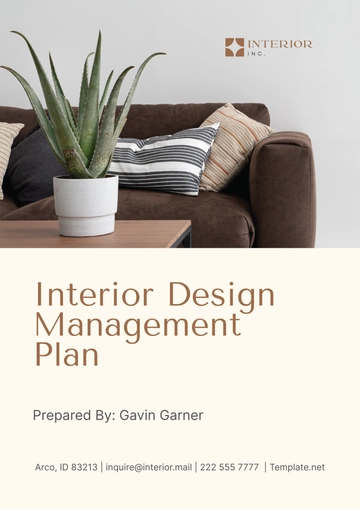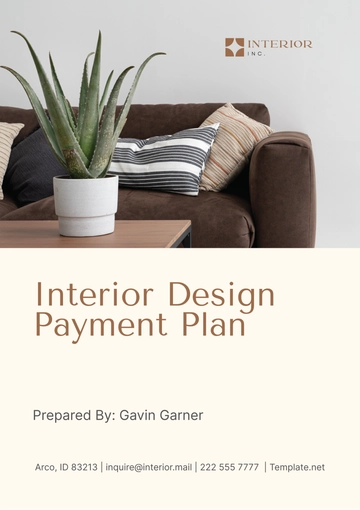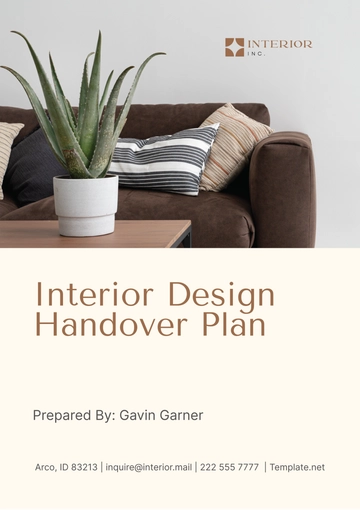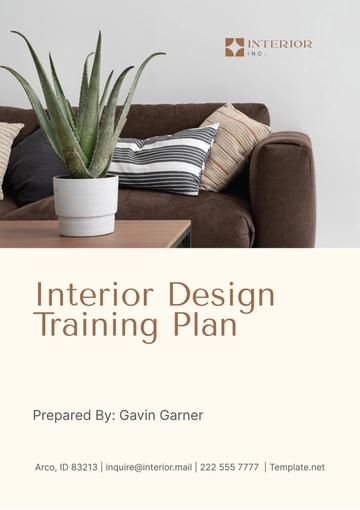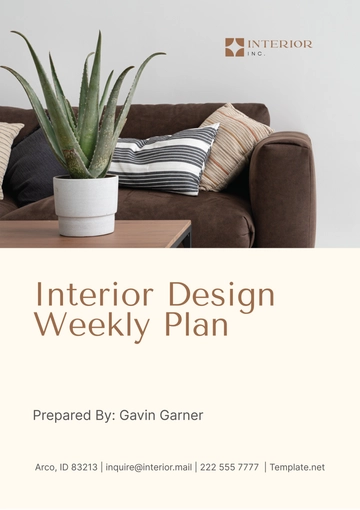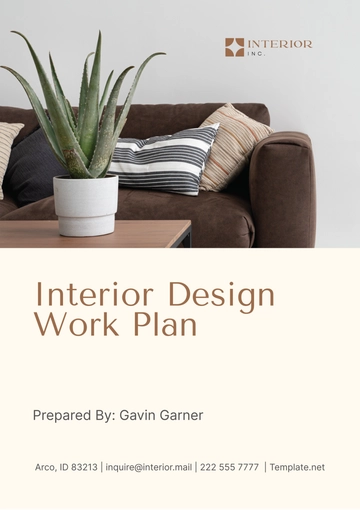Free Interior Design Budget Plan
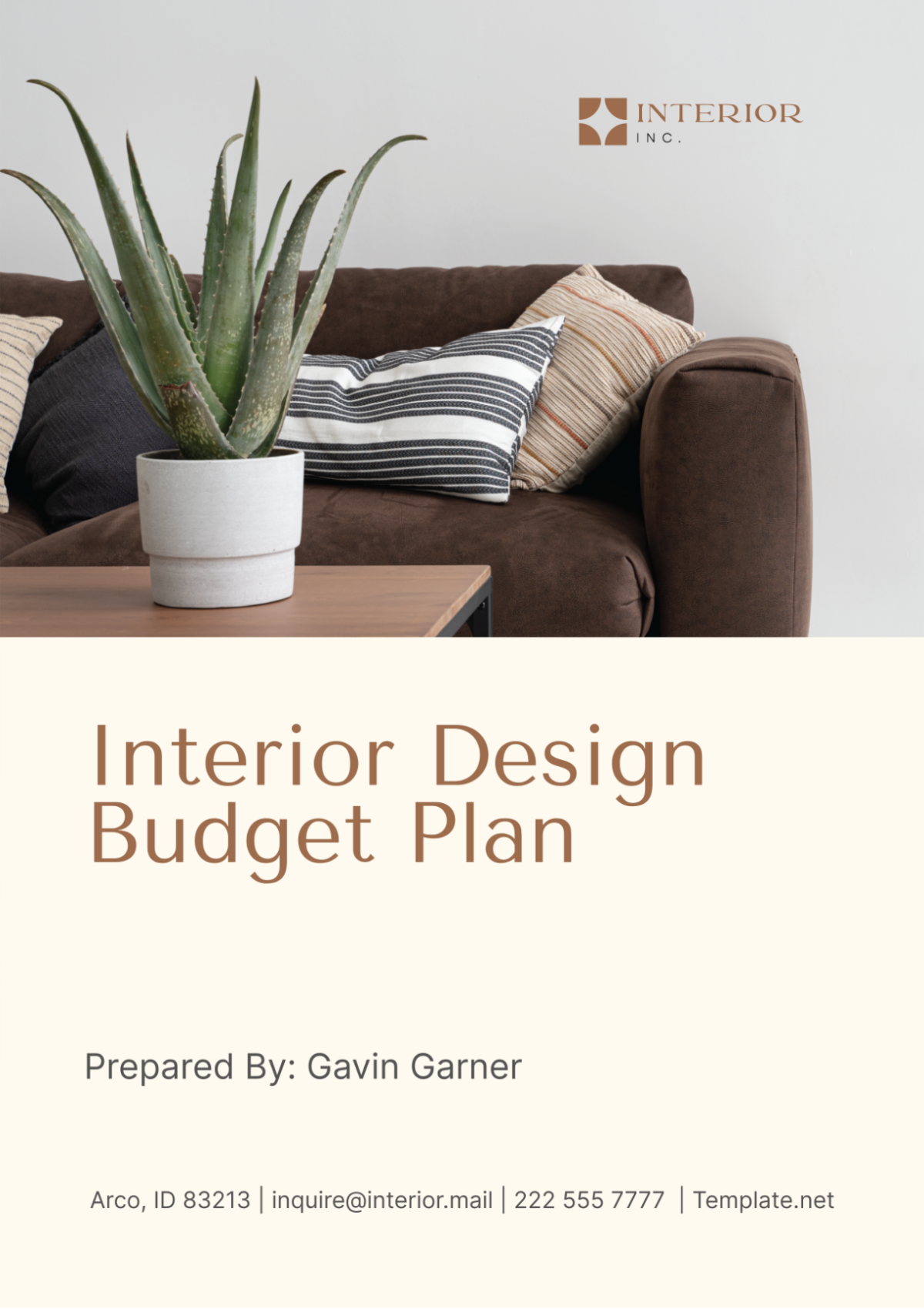
1. Introduction
Welcome to the Interior Design Budget Plan prepared by [Your Company Name]. This document serves as a strategic blueprint for the financial management of interior design projects. Effective budgeting is essential to project success, ensuring that design aspirations are achieved within financial constraints without compromising on quality.
The purpose of this plan is to outline anticipated costs associated with the interior design project, ensuring that all financial considerations are transparent and managed from start to finish. By adhering to this budget plan, we aim to maximize your investment, control spending, and enhance the overall value of the project.
2. Project Overview
Project Name: Luxe Urban Living
Client: [Client Names]
Project Location: [Project Address]
Start Date: [Date]
Completion Date: [Date]
Objective
The primary goal of this project is to transform the client's new condominium into a modern, luxurious living space that optimizes functionality while reflecting their personal style.
Goals
To create a visually appealing and practical environment suitable for urban living.
To ensure resource management effectiveness, keeping the project within the agreed budget.
To achieve project milestones on time, aligning with the planned schedule.
Project Scope
Design Phase: Concept development, spatial planning, 3D modeling, and material selection.
Construction Phase: Structural changes, electrical and plumbing updates, and installations.
Finishing Phase: Furniture selection, artwork placement, and final styling.
3. Budget Planning Process
The budget planning process for an interior design project at [Your Company Name] involves the following detailed steps to ensure accuracy and comprehensive coverage:
Step 1: Requirement Gathering
Initial conversations with the clients primarily concentrate on understanding their vision, preferences, and financial constraints, and these are further supplemented by multiple evaluations of the site to carefully assess the space and its possibilities.
Step 2: Preliminary Cost Estimation
A rough cost estimate is prepared, outlining potential expenses for materials, labor, design fees, and other foreseeable costs based on the initial requirements and site conditions.
Step 3: Budget Approval
This preliminary budget is reviewed in detail with the [Client Names]. Adjustments are made as needed to tailor the budget to their expectations and financial limits. Following adjustments, the budget is finalized and approved by the clients.
Step 4: Ongoing Monitoring and Adjustments
Throughout the duration of the project, regular reviews and adjustments of the budget are conducted to accommodate changes and address unforeseen costs in an efficient manner. This systematic approach ensures that as the project progresses, all financial aspects are continually updated and optimized to reflect current needs and conditions.
Budgeting Tools
[[Your Company Name] utilizes sophisticated budgeting software that enables the real-time management of budgets. This technology facilitates the generation of detailed reports and enhances effective tracking mechanisms, all of which are essential for maintaining the financial integrity of the project and ensuring it remains on budget.
4. Budget Breakdown
Table 1: Detailed Budget for Luxe Urban Living Project
Category | Estimated Cost | Details |
|---|---|---|
Materials and Supplies | $45,000 | Includes high-quality furnishings, custom cabinetry, luxury flooring, and designer fixtures. |
Labor Costs | $30,000 | Covers all craftsmen, electricians, plumbers, and decorators required for installation and modifications. |
Professional Fees | $25,000 | Fees for design services, project management, and consultations. |
Permits and Licenses | $5,000 | Required for structural changes and installations. |
Contingency Fund | $10,000 | Set aside to manage unexpected expenses, comprising 10% of the total budget. |
Total | $115,000 | Total estimated cost for the complete project |
Materials and Supplies:
This includes all essential components like tiles, paints, bespoke furniture, and decorative lighting sourced from top suppliers to ensure both aesthetics and durability.
Labor Costs:
This encompasses payments for all skilled and general labor required throughout the project's phases, from initial demolition to final installations.
Professional Fees:
These are comprehensive fees charged by [Your Company Name] for detailed design work, ongoing project management, and client consultations throughout the project lifecycle.
Permits and Licenses:
All necessary legal permissions from local authorities to ensure the project adheres to building codes and regulations.
Contingency Fund:
A crucial buffer against unforeseen circumstances, ensuring project continuity without financial interruptions.
5. Funding Sources
Table 2: Funding Overview for Luxe Urban Living
Source | Amount | Details |
|---|---|---|
Client's Budget | $100,000 | The primary source of funding is provided directly by the clients. |
Personal Loan | $15,000 | A low-interest loan obtained by the Harts to ensure ample funding throughout the project. |
Total | $115,000 | Total funds available to cover all project costs. |
Client's Budget
The clients have set aside a significant amount of money from their personal savings, with the intention of covering the majority of the expenses associated with the project. This approach is aimed at guaranteeing that they maintain direct control over the financial outlays involved.
Personal Loan
In order to ensure that the entire scope of the project can be covered in a comfortable manner without making any sacrifices in terms of quality or design, the clients have opted to secure a personal loan. This financial arrangement affords them the necessary flexibility to potentially extend and enhance specific aspects of the design, should they choose to do so.
6. Cost-Saving Strategies
Implementing cost-saving measures without compromising on quality is a crucial component of financial planning for any interior design project. At [Your Company Name], we are dedicated to ensuring that [Client Names] achieves its vision while making the most efficient use of its budget. Here are several strategies we employ to manage costs effectively:
Table 3: Cost-Saving Strategies
Strategy | Implementation | Estimated Savings |
|---|---|---|
Bulk Purchasing | Buying materials in bulk for flooring, paint, and fixtures to obtain discounts. | 10-15% on materials |
Reusing Materials | Repurposing existing furniture and fixtures where possible. | 5-10% on new purchases |
Energy-Efficient Designs | Incorporating LED lighting and energy-efficient appliances to reduce long-term costs. | Reduce utility bills by up to 20% |
Competitive Bidding | Obtaining multiple bids for contractor work to ensure the best prices. | 5-15% on labor costs |
Off-season Scheduling | Planning construction during off-peak seasons to avail lower rates. | 10% on overall project costs |
Detailed Explanation:
Bulk Purchasing: By ordering larger quantities of materials such as tiles, hardwood floors, and paint, we can negotiate better prices with suppliers, thus reducing the cost per unit. This strategy is especially effective for large-scale projects or multiple rooms.
Reusing Materials: We evaluate existing pieces such as furniture, light fixtures, and even certain architectural elements that can be refurbished or repurposed. This not only saves money but also adds a unique character to the space.
Energy-Efficient Designs: Design choices that focus on sustainability not only benefit the environment but also result in savings for [Client Names] through reduced energy consumption. Incorporating elements like solar panels, energy-efficient windows, and smart home technologies can significantly decrease future utility bills.
Competitive Bidding: For all contractor-required tasks, we solicit bids from multiple providers to ensure that [Client Names] receives the best possible rates for the quality of work required. This process is transparent, and the final selection is based on a balance of cost, expertise, and previous client feedback.
Off-season Scheduling: Scheduling the project during the contractor’s off-season can lead to reduced rates and more attentive service, as providers are not as stretched as during peak times.
7. Monitoring and Adjustments
Monitoring the budget throughout the project is vital to ensure that expenses align with the planned estimates. [Your Company Name] employs a proactive approach to track spending and make adjustments as needed to stay within the financial framework established with [Client Names].
Table 4: Budget Monitoring Schedule
Frequency | Activity | Purpose |
|---|---|---|
Weekly | Review of expenses against the budget | To ensure early detection of budget variances. |
Monthly | Detailed financial report to [Client Names] | To maintain transparency and adjust forecasts. |
Ad-Hoc | Adjustment meetings with [Client Names] | To discuss and approve unforeseen expenses or savings. |
Process:
Weekly Expense Reviews: Every week, our project manager compiles all expenses related to the project, comparing them against the budgeted figures. This regular scrutiny helps in identifying any discrepancies early, allowing for timely adjustments.
Monthly Financial Reporting: We provide [Client Names] with a detailed report of all financial activities associated with the project. This report includes a summary of expenditures, the status of the contingency fund, and projections for the upcoming period.
Ad-Hoc Adjustment Meetings: If significant budget deviations occur, we schedule meetings with [Client Names] to discuss the issues. During these sessions, we present options for cost adjustments or reallocation of resources to address any financial overruns.
8. Documentation and Reporting
Accurate documentation and regular reporting are essential for maintaining financial control and ensuring accountability. [Your Company Name] adheres to rigorous standards for record-keeping and communication with [Client Names] throughout the project duration.
Table 5: Documentation and Reporting Protocols
Document | Frequency | Purpose |
|---|---|---|
Invoices and Receipts | As incurred | To validate all expenditures and maintain a financial audit trail. |
Progress Reports | Bi-weekly | To update [Client Names] on the project’s financial status and progress. |
Final Financial Report | Post-project | To provide a comprehensive review of all financial transactions and outcomes. |
Process:
Invoices and Receipts: All financial transactions are accompanied by invoices or receipts, which are meticulously filed both in digital and physical formats. This ensures that every financial transaction is traceable and verifiable.
Progress Reports: These reports offer a snapshot of the project's financial health and progression, highlighting how the budget is being utilized, outlining any potential financial risks, and forecasting future spending.
Final Financial Report: At the conclusion of the project, a detailed financial report is prepared. This report includes a full breakdown of all costs, comparisons against the initial budget, and explanations for any variances. This document serves as a final account of the stewardship of [Client Names]'s funds throughout the project.
9. Conclusion
In conclusion, the budget plan prepared by [Your Company Name] for [Client Names] has been meticulously crafted to ensure financial clarity and control throughout the duration of the interior design project. By employing strategic cost-saving measures, rigorous monitoring, and thorough documentation, we aim to deliver a project that not only meets but exceeds the aesthetic and functional expectations of [Client Names], while adhering to the agreed financial parameters. Our commitment to financial integrity and transparency underpins our mission to provide superior interior design services that reflect the trust placed in us by [Client Names].
- 100% Customizable, free editor
- Access 1 Million+ Templates, photo’s & graphics
- Download or share as a template
- Click and replace photos, graphics, text, backgrounds
- Resize, crop, AI write & more
- Access advanced editor
Plan your project's finances meticulously with Template.net's Interior Design Budget Plan Template. This customizable and editable tool, enhanced by our AI Editor Tool, allows designers to allocate resources effectively, ensuring projects stay within budget while achieving desired aesthetics and functionality. Essential for managing costs efficiently in every design phase.
You may also like
- Finance Plan
- Construction Plan
- Sales Plan
- Development Plan
- Career Plan
- Budget Plan
- HR Plan
- Education Plan
- Transition Plan
- Work Plan
- Training Plan
- Communication Plan
- Operation Plan
- Health And Safety Plan
- Strategy Plan
- Professional Development Plan
- Advertising Plan
- Risk Management Plan
- Restaurant Plan
- School Plan
- Nursing Home Patient Care Plan
- Nursing Care Plan
- Plan Event
- Startup Plan
- Social Media Plan
- Staffing Plan
- Annual Plan
- Content Plan
- Payment Plan
- Implementation Plan
- Hotel Plan
- Workout Plan
- Accounting Plan
- Campaign Plan
- Essay Plan
- 30 60 90 Day Plan
- Research Plan
- Recruitment Plan
- 90 Day Plan
- Quarterly Plan
- Emergency Plan
- 5 Year Plan
- Gym Plan
- Personal Plan
- IT and Software Plan
- Treatment Plan
- Real Estate Plan
- Law Firm Plan
- Healthcare Plan
- Improvement Plan
- Media Plan
- 5 Year Business Plan
- Learning Plan
- Marketing Campaign Plan
- Travel Agency Plan
- Cleaning Services Plan
- Interior Design Plan
- Performance Plan
- PR Plan
- Birth Plan
- Life Plan
- SEO Plan
- Disaster Recovery Plan
- Continuity Plan
- Launch Plan
- Legal Plan
- Behavior Plan
- Performance Improvement Plan
- Salon Plan
- Security Plan
- Security Management Plan
- Employee Development Plan
- Quality Plan
- Service Improvement Plan
- Growth Plan
- Incident Response Plan
- Basketball Plan
- Emergency Action Plan
- Product Launch Plan
- Spa Plan
- Employee Training Plan
- Data Analysis Plan
- Employee Action Plan
- Territory Plan
- Audit Plan
- Classroom Plan
- Activity Plan
- Parenting Plan
- Care Plan
- Project Execution Plan
- Exercise Plan
- Internship Plan
- Software Development Plan
- Continuous Improvement Plan
- Leave Plan
- 90 Day Sales Plan
- Advertising Agency Plan
- Employee Transition Plan
- Smart Action Plan
- Workplace Safety Plan
- Behavior Change Plan
- Contingency Plan
- Continuity of Operations Plan
- Health Plan
- Quality Control Plan
- Self Plan
- Sports Development Plan
- Change Management Plan
- Ecommerce Plan
- Personal Financial Plan
- Process Improvement Plan
- 30-60-90 Day Sales Plan
- Crisis Management Plan
- Engagement Plan
- Execution Plan
- Pandemic Plan
- Quality Assurance Plan
- Service Continuity Plan
- Agile Project Plan
- Fundraising Plan
- Job Transition Plan
- Asset Maintenance Plan
- Maintenance Plan
- Software Test Plan
- Staff Training and Development Plan
- 3 Year Plan
- Brand Activation Plan
- Release Plan
- Resource Plan
- Risk Mitigation Plan
- Teacher Plan
- 30 60 90 Day Plan for New Manager
- Food Safety Plan
- Food Truck Plan
- Hiring Plan
- Quality Management Plan
- Wellness Plan
- Behavior Intervention Plan
- Bonus Plan
- Investment Plan
- Maternity Leave Plan
- Pandemic Response Plan
- Succession Planning
- Coaching Plan
- Configuration Management Plan
- Remote Work Plan
- Self Care Plan
- Teaching Plan
- 100-Day Plan
- HACCP Plan
- Student Plan
- Sustainability Plan
- 30 60 90 Day Plan for Interview
- Access Plan
- Site Specific Safety Plan
